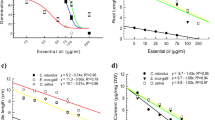Abstract
Citronella grass (Cymbopogon nardus) is a perennial herb. Many researchers have studied the exploitation of the active compounds in this plant for medicinal purposes, but there have been no studies on its phytotoxic compounds. Therefore, we investigated the phytotoxic active compounds in the roots of C. nardus. A significant inhibition was observed on the germination of cress (Lepidium sativum L.), lettuce (Lactuca sativa L.), barnyard grass (Echinochloa crus-galli L.), and Italian ryegrass (Lolium multiflorum Lam.) by the aqueous methanol extract of C. nardus roots. The extract decreased the total germination percentage (GP) and germination index (GI, progressive total of daily cumulative germination), and extended the time required for 50% germination (T 50) of all test species. A phytotoxic compound of the extract was isolated and identified as N-octanoyl tyramine by spectral analysis. This compound showed the inhibition on the germination of cress and barnyard grass. The decline in GP, GI, and T 50 was observed at concentrations of 30–2000 μM of N-octanoyl tyramine. The compound also showed the significant inhibition on the growth of cress and barnyard grass seedlings at concentrations greater than 100 and 300 μM, respectively. This study suggests that C. nardus could produce phytotoxic compounds, and N-octanoyl tyramine may be responsible for its phytotoxic activity.




Similar content being viewed by others
References
Ahmed M, Wardle DA (1994) Allelopathic potential of vegetative and flowering ragwort (Senecio jacobaea L.) plants against associated pasture species. Plant Soil 164:61–68
Association of Official Seed Analysis (AOSA) (1983) Seed vigor testing handbook. Contribution No. 32 to the handbook on seed testing. AOSA, Ithaca, NY, USA
Bais HP, Weir TL, Perry LG, Gilroy S, Vivanco JM (2006) The role of root exudates in rhizosphere interactions with plants and other organisms. Annu Rev Plant Biol 57:233–266
Baumgarten A, Spiegel H (2004) Phytotoxicity (Plant tolerance). Agency for Health and Food Safety, Vienna
Chen Q, Xu S, Wu T, Guo J, Sha S, Zheng X, Yu T (2014) Effect of citronella essential oil on the inhibition of postharvest Alternaria alternate in cherry tomato. J Sci Food Agric 94:2441–2447
Coolbear P, Francis A, Grierson D (1984) The effect of low temperature pre-sewing treatment on the germination performance and membrane integrity of artificially age tomato seeds. J Exp Bot 35:1609–1617
Farooq M, Basra SMA, Ahmad N, Hafeez K (2005) Thermal hardening: a new seed vigor enhancement tool in rice. J Integr Plant Biol 47:187–193
Heidarzade A, Esmaeili M, Pirdashti H (2012) Common allelochemicals in root exudates of barnyardgrass (Echinochloa crus-galli L.) and inhibitory potential against rice (Oryza sativa) cultivars. Intl Res J Appl Basic Sci 3:11–17
Hooper AM, Tsanuo MK, Chamberlain K, Tittcomb K, Scholes J, Hassanali A, Khan ZR, Pickett JA (2010) Isoschaftoside, a C-glycosylflavonoid form Desmodium uncinatum root exudate, is an allelochemical against the development of Striga. Phytochemistry 71:904–908
Jantamas S, Matan N, Aewsiri T (2016) Improvement of antifungal activity of citronella oil against Aspergillus flavus on rubberwood (Hevea brasiliensis) using heat curing. JTFS 28:39–47
Liu Q, Xu R, Yan Z, Jin H, Cui H, Lu L, Zhang D, Qin B (2013) Phytotoxic allelochemicals from roots and root exudates of Trifolium pratense. J Agric Food Chem 61:6321–6327
Luangnarumitchai S, Lamlertthon S, Tiyaboonchai W (2007) Antimicrobial activity of essential oils against five strains of Propionibacterium acnes. MUJPS 34:60–64
Mann JD, Mudd SH (1963) Alkaloids and plant metabolism: IV. The tyramine methylpherase of barley roots. J Biol Chem 238:381–385
Maun MA, Barrett SCH (1986) The biology of Canadian weeds. 77. Echinochloa crus-galli (L.) Beauv. Can J Plant Sci 66:739–759
Naeem M, Mahmood A, Ihsan MZ, Daur I, Hussain S, Aslam Z, Zamanan SA (2016) Trianthema portulacastrum and Cyperus rotundus interference in maize and application of allelopathic crop extracts for their effective management. Planta Daninha 34:209–218
Nakahara K, Alzoreky NS, Yoshihashi T, Nguyen HTT, Trakoontivakorn G (2003) Chemical composition and antifungal activity of essential oil from Cymbopogon nardus (citronella grass). JARQ 37:249–252
Oyen LPA, Dung NX (1999) Plant resources of South-east Asia no. 19: Essential-oil plants. Backhuys
Ranal MA, Santana DGD (2006) How and why to measure the germination process? Revista Brasil Bot 29:1–11
Rice EL (1984) Allelopathy, 2nd edn. Academic Press, Orlando
Servillo L, Giovane A, D’Onofrio N, Casale R, Cautela D, Ferrari G, Balestrieri ML, Castaldo D (2014) N-methylated derivatives of tyramine in Citrus genus plants: identification of N,N,N-trimethyltyramine (candicine). J Agric Food Chem 62:2679–2684
Shah SH, Khan EA, Shah H, Ahmad N, Khan J, Sadozai GU (2016) Allelopathic sorghum water extract helps to improve yield of sunflower (Helianthus annuus L.). Pak J Bot 48:1197–1202
Singh A, Singh M, Singh S (2001) Effective utilization of distillation waste as organic mulch for weed management in the aromatic grass, Citronella java. Int J Pest Manag 24:253–257
Sun WS, Lee HS, Park JM, Kim SH, Yu JH, Kim JH (2001) YUA001, a novel aldose reductase inhibitor isolated from alkalophilic Corynebacterium sp. YUA25. II. Chemical modification and biological activity. J Antibiot (Tokyo) 54:827–830
Suwitchayanon P, Kato-Noguchi H (2014) Allelopathic activity of leaves, stalks and roots of Cymbopogon nardus. Emir J Food Agric 26:440–447
Uddin MR, Thwe AA, Kim YB, Park WT, Chae SC, Park SU (2013) Effects of jasmonates on sorgolone accumulation and expression of genes for sorgoleone biosynthesis in sorghum roots. J Chem Ecol 39:712–722
United States Environmental Protection Agency (EPA) (1997) Reregristration eligibility decision (RED) facts oil of Citronella. U.S. Government Printing Office, Washington, DC
Wei LS, Wee W (2013) Chemical composition and antimicrobial activity of Cymbopogon nardus citronella essential oil against systemic bacteria of aquatic animals. Iran J Microbiol 5:147–152
Acknowledgements
We would like to thank the providing scholarship from Government of Japan for the first author to carry out this research.
Author information
Authors and Affiliations
Corresponding author
Additional information
Communicated by A. Krolicka.
Rights and permissions
About this article
Cite this article
Suwitchayanon, P., Ohno, O., Suenaga, K. et al. N-Octanoyl tyramine, a phytotoxic compound in the roots of Cymbopogon nardus . Acta Physiol Plant 39, 123 (2017). https://doi.org/10.1007/s11738-017-2419-4
Received:
Revised:
Accepted:
Published:
DOI: https://doi.org/10.1007/s11738-017-2419-4




